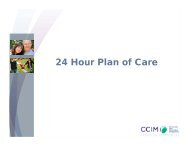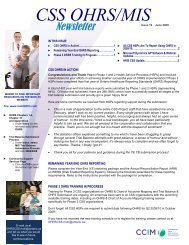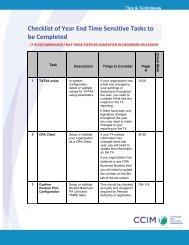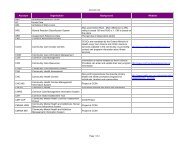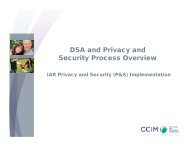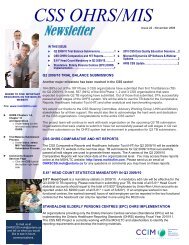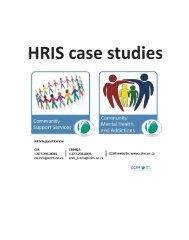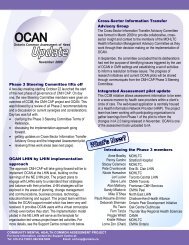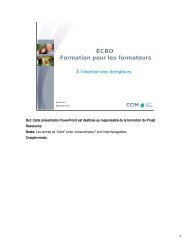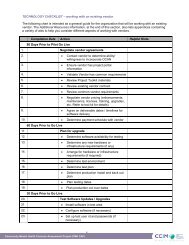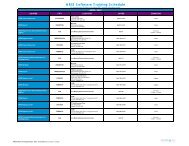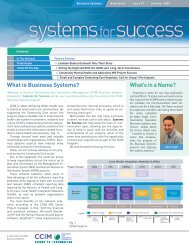RAI-MDS 2.0 Nutritional Care Resource Guide April 2011 - CCIM
RAI-MDS 2.0 Nutritional Care Resource Guide April 2011 - CCIM
RAI-MDS 2.0 Nutritional Care Resource Guide April 2011 - CCIM
- No tags were found...
Create successful ePaper yourself
Turn your PDF publications into a flip-book with our unique Google optimized e-Paper software.
8 Documentation by the dietitian in the clienthealth record should be permanent and cannotbe altered - in ink or electronic medium that ispermanent, no blank lines between writtenentries or using electronic medium that does notallow altering. Section E (11)Record Keeping<strong>Guide</strong>lines, 20049 The client health record should be residentfocusedincorporating resident and/or familygoals. Section E (7) Record Keeping <strong>Guide</strong>lines,2004Home develops policy to determine who has access to make changes withinthe <strong>RAI</strong>-<strong>MDS</strong> <strong>2.0</strong> coding, RAPs documentation and care plan. Softwarevendor may have built-in lock or read only features in the software.The dietitian should discuss with the home the need to confirm with softwarevendor an audit feature to enable auditing of information for example: whatinformation was entered or changed, when and by whom.The process for accurately assessing each resident includes the gathering ofinformation from multiples sources, in particular from the resident and his/herfamily. <strong>RAI</strong>-<strong>MDS</strong> <strong>2.0</strong> is a comprehensive, multi-domain assessment of eachresident’s functional status. When completed, the triggered RAPs andoutcome measures that identify each resident’s needs and or/strengthsfacilitate the development of a resident-focused plan of care. It is important tocontinue to include the resident and his/her family in decision-making for goalsof care and the development of the care plan interventions.Evidence of resident/representative input and source of diet history informationcan be documented in the RAP/non-triggered RAP assessment summary orthe interdisciplinary progress note.Note: a record of consent should be obtained from clients or substitutedecision makers whenever dietitians are recommending a nutritional therapy(therapeutic diet, tube feeding or TPN). While a signed consent form from aclient may be desirable, it is not necessary. Section C Record Keepingguidelines 2004.10 The client record includes Progress notescontaining a record of services rendered,subjective and objective re-evaluation andchanges in the client's nutritional status. Section(7)(h) of the College’s Proposed RecordsRegulation11 The dietitian uses a structured system to identifyclients at nutrition risk. Section 17.1 EssentialCompetencies for Dietetic Practice 200612 Documentation by the dietitian in the clienthealth record should be signed (name andcredential-RD) by the individual who saw theclient. Never chart or sign an entry on behalf ofanother dietitian. Section E (14)Record Keeping<strong>Guide</strong>lines, 2004The specific location of where to document or demonstrate ongoing monitoringand evaluation of resident’s nutritional status will depend on the home’s policy.This may include incidental charting in the progress notes, or in the RAP/nontriggered RAP Summaries Step #2The <strong>RAI</strong>-<strong>MDS</strong> <strong>2.0</strong> offers standardized baseline information for initiating acomprehensive nutritional assessment. It identifies some key measurableindicators of nutritional risk. The dietitian/nutrition manager is required toaddress all pertinent diagnoses, health status, individual’s eating habits,religious and cultural preferences and any nutrition care needs that have orhave not been identified in <strong>RAI</strong>-<strong>MDS</strong> <strong>2.0</strong> and/or triggered by RAPs (taken fromthe <strong>Resource</strong> <strong>Guide</strong> for Nutrition care - Part A).Following the <strong>RAI</strong>-<strong>MDS</strong> <strong>2.0</strong> assessment and RAPs analysis, the dietitian will: Use his/her clinical judgment to make a decision to conduct furtherassessment if appropriate; andDetermine if the resident is at nutritional risk; assigning nutritional risk level toresident (for example: high, moderate or low) is not a requirement, dependingon home policyConsult the <strong>RAI</strong> Coordinator to see if the software includes areas for the nameand credential of the individual who saw the resident.For Information: 416.327.7625 21ltchrai@ontario.ca21



